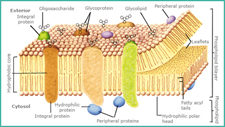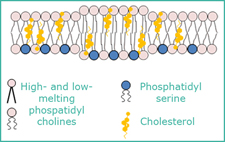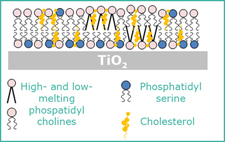 |
According to the fluid mosaic model, cell membrane (picture on the left) is envisaged as a fluid lipid bilayer (~ 5 nm thick) with transmembrane proteins embedded in it and peripheral proteins bound to it.[Singer and Nicolson 1972, Science 175, 720; Jacobson et al. 1995, Science 268, 1441] This structure performs a wide variety of barrier, selective transport, and signaling functions in the cells. |
 |
Although the lipid bilayer is fluid (i.e., lipids diffuse rapidly in the plane of the membrane), the lipids within it are distributed non-randomly. There are compositional heterogeneities in the plane of the membrane (“lipid rafts”) on one hand and transverse phospholipid asymmetry on the other. |
How can lipid membranes be both fluid and laterally heterogeneous is discussed in Honerkamp-Smith et al. 2009, Biochim. Biophys. Acta 1788, 53 and Bagatolli et al. 2009, Prog. Lipid. Res. 49, 378. An interesting discussion of lipid rafts appears here: Leslie M. 2011, Science 334, 1046.
Transverse phospholipid asymmetry refers to the fact that the compositions of the two leaflets of the cell membrane are not the same.[Verkleij et al. 1973, Biochm. Biophys. Acta 323, 178] The outer leaflet consists predominantly of zwitterionic lipids (phosphatidyl choline, sphingomyelin, etc), while the inner leaflet contains “reactive” phospholipids such as phosphatidyl serine (PS, shown in blue in the figure). This lipid distribution is tightly regulated [Daleke et al. 2008, Curr. Opin. Hematol. 15, 191] and has important physiological consequences in blood coagulation, inflammation, and apoptosis.[Zwaal et al. 1997, Blood 89, 1121]
 |
Modeling both the lateral and the transverse organization of lipids in membranes has been difficult. We were able to prepare solid-supported lipid bilayers with physiological lipid compositions and asymmetric lipid distributions on TiO2. We are using methods such as neutron reflectometry and secondary ion mass spectrometry to quantify lipid compositions and distributions in these bilayers and plan to use them to study lipid diffusion and phase separation in asymmetric systems. |
Ultimately, our aim is to control lipid distribution in situ. We strive both to understand cell membrane organization and to precisely control lipid composition and organization at solid surfaces for biosensor and biomaterial applications. We are also using solid-supported lipid systems to study blood coagulation and to organize transmembrane proteins at solid-liquid interfaces.
More details are available at www.ireviakine.net.





